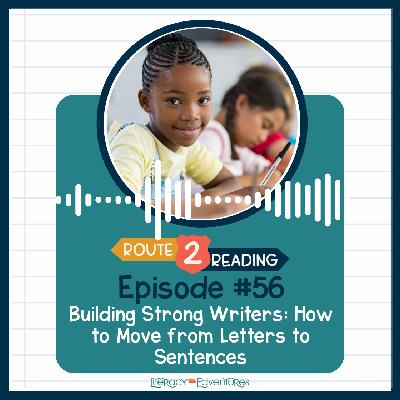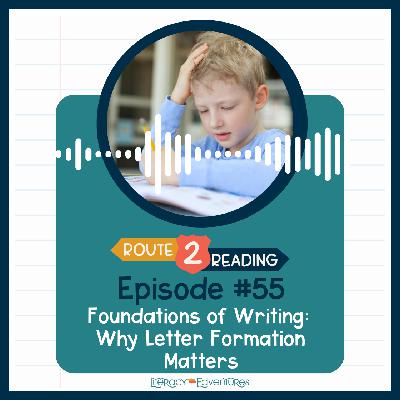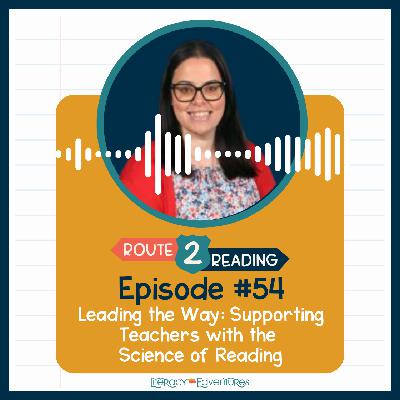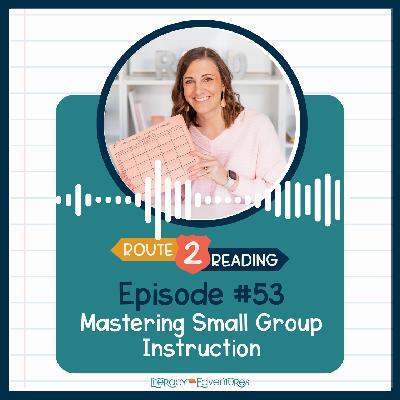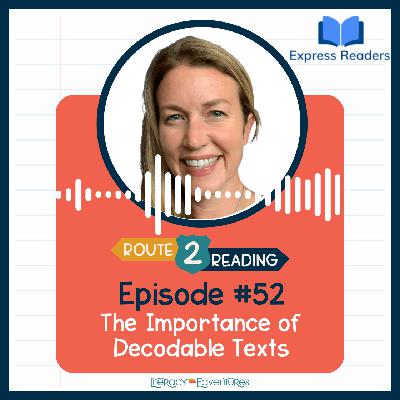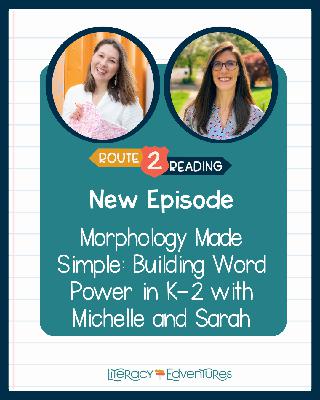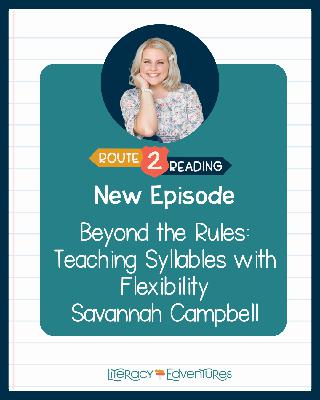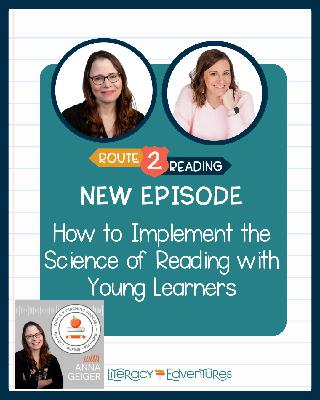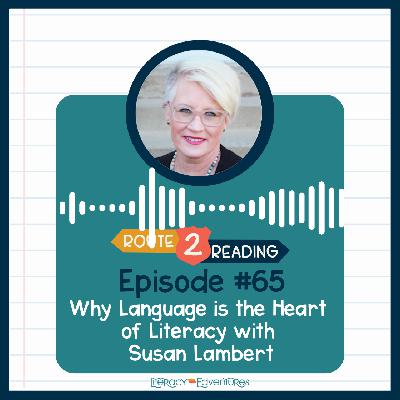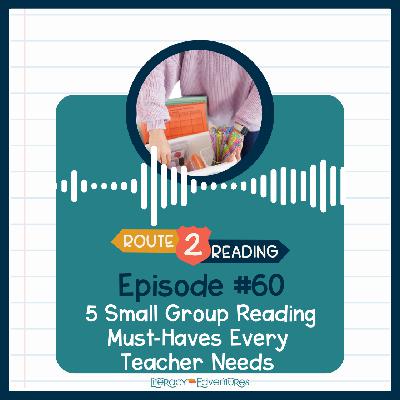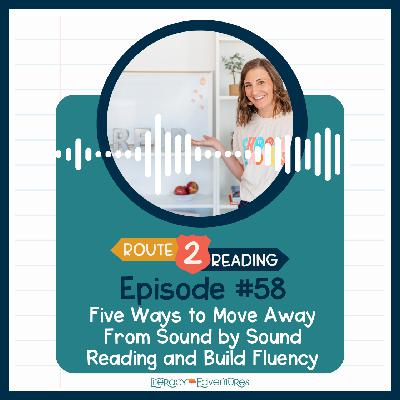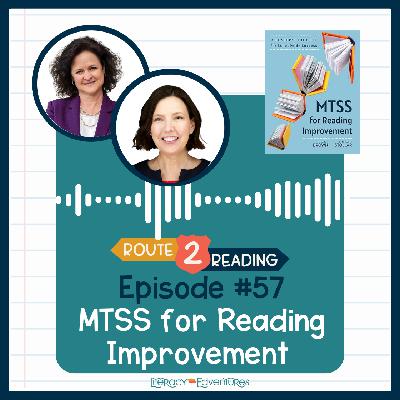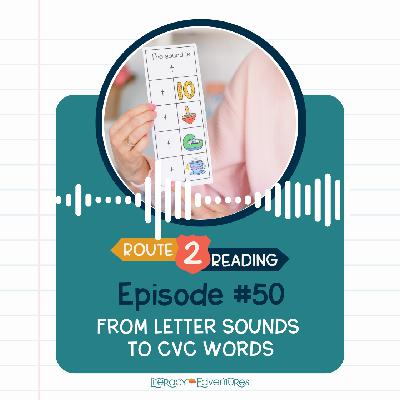Discover Route2Reading
Route2Reading

Route2Reading
Author: Amie Burkholder
Subscribed: 19Played: 225Subscribe
Share
© 2022
Description
A step-by-step roadmap guides you through a reader's journey—at every level. This podcast was made for you if you're ready to, get clear on what structured literacy is and the science behind it. Join me to learn precisely what your struggling readers need and find ways to reach them.
70 Episodes
Reverse
Episode Summary: In today's episode, we're tackling one of the biggest transitions in early literacy—helping students move from writing individual letters to constructing full sentences. If you've ever wondered how to bridge the gap between handwriting and confident writing, this episode is for you! We'll walk through: ✅ How to transition from letter formation to writing words ✅ The role of phonemic awareness and sound-to-letter mapping in writing ✅ Scaffolded word-building to strengthen encoding skills ✅ Sentence structure—teaching kids what makes a complete thought ✅ Engaging strategies like "Who/Do" sentences and The Missing Piece Game ✅ Why dictation and shared writing are essential for early writers ✅ How to make writing meaningful and connected to real-life experiences By the end of this episode, you'll have a clear, step-by-step approach to support your students as they grow into confident writers! FULL SHOW NOTES HERE
Episode Summary: Handwriting often gets pushed aside, but it's a game-changer for literacy success. In this episode, we're diving into: ✔️ Why handwriting matters for reading and spelling ✔️ Research-backed strategies to build fluency ✔️ The 5 essential components of writing success ✔️ Simple, effective ways to fit handwriting into your day By the end of this episode, you'll have practical strategies to help students move from letters to words to full sentences with confidence! FULL SHOW NOTES HERE
All About Lisa Russo: Administrator in New York Public Schools at P.S. 152. Became a teacher in 2022 at P.S. 152 and taught for 13 years in a variety of grades. Pursued a masters and became assistant principal at P.S. 152 for seven years - the same school she grew up in! Now serves as the principal at P.S. 152. You mention that you have former students who return as staff members or with their own children. Can you talk about that? It's so incredible and unique - a true family. It makes my job more important because I have a great connection with the families, staff, and kids. I grew up alongside them! Having my own students come back or have their children is just so special. FULL SHOW NOTES HERE
Small group instruction: where the magic happens. It's here where we get to see those long-awaited lightbulb moments. But with so many needs and so little time, it can feel overwhelming. Today, we will help you simplify your planning, chat about why small groups are so important, and give you all the tools you need to make your small group instruction successful. Why Small Groups Matter Small groups allow us to meet them where students are and provide targeted support. In fact, research supports that this time is one of the most effective ways to boost reading success. But with so much planning, what do we do? We follow a structure and this three-part framework: Warm-up with cumulative review Explicit teaching Application. Following a framework takes the guessing out of planning and ensures that your lessons are aligned with the science of reading. This framework works because it's digestible, it's consistent, it's aligned with the science of reading, it's efficient for teachers, and gives students a confident path towards reading. FULL SHOW NOTES HERE
LE Podcast #52 The Importance of Decodable Text with Elise Lovejoy All About Elise Lovejoy: Former teacher and currently serves as an probono interventionist at a nearby school. Runs Express Readers, a foundational skills reading program as well as a decodable book series. Passionate about the science of reading. FULL SHOW NOTES HERE
LE Podcast #51 New Year, New Goals: Using Data to Reset and Plan for 2025 What's the most important question we can ask ourselves as teachers and reading specialists and coaches? That's easy: How do we teach reading in a way so that we can reach every student and every need? The answer may not be what you think! It all starts with assessments. Analyzing data we get from assessments can completely transform our reading instruction and help us reach every student. Today, we're doing a deep dive into assessments and why we need them to drive our reading instruction. FULL SHOW NOTES HERE
Have you ever wondered what it takes to write your own decodable books—or how to make them both phonics-aligned and fun to read? In this episode of the Route2Reading Podcast, Amie sits down with Brooke Vitale, former children's book editor turned author and co-creator of Charge Mommy Books, to talk about how she began writing decodable texts during the pandemic and what she's learned along the way. Brooke shares her journey from working with top publishers like Penguin and Disney to creating her own line of decodable readers that blend phonics progression, story engagement, and authentic language. Together, Amie and Brooke unpack practical tips for teachers who want to fill gaps in their phonics sequence or even try writing their own decodables. CLICK HERE FOR FULL SHOW NOTES
Are you using decodable books the right way? In this episode, we're breaking down six of the most common mistakes teachers make with decodable texts—and how to fix them. You'll learn how to align books to your phonics lessons, prep students before reading, balance decoding with meaning, and know when it's time to move beyond decodables. Practical, honest, and grounded in the Science of Reading—with insights from experts like Wiley Blevins, Heidi Anne Mesmer, and Jeanne Chall. READ FULL SHOW NOTES HERE
What if I told you morphology isn't too advanced for young readers—it's actually the missing piece that makes decoding, spelling, and vocabulary stick? In this episode, I'm joined by two of my favorite literacy leaders, Michelle Sullivan and Sarah Paul, to talk all things morphology. We unpack what it is, why it matters from the very start of reading instruction, and how to make it engaging and approachable for even our youngest students. CLICK HERE FOR FULL SHOW NOTES
Syllables can feel "big" or confusing—but they don't have to be. In this episode, I chat with reading specialist Savannah Campbell (Campbell Creates Readers) about how to make syllable instruction clear, doable, and effective from k–5. We cover the six syllable types, how (and whether) to teach division patterns, set-for-variability, and simple multisensory tools that help kids read and spell multisyllabic words with confidence. FULL SHOW NOTES HERE
In this episode, I'm excited to share a conversation I originally had on the Triple R Teaching Podcast with Anna Geiger (The Measured Mom). Together, we dive into my book Literacy Unlocked: How to Implement the Science of Reading with Young Learners and explore how to bridge research with practical classroom application. We cover the real-life challenges teachers face when it comes to foundational literacy skills and the shifts required to move from balanced literacy to the science of reading. This episode is packed with actionable ideas that you can take straight into your classroom. FULL SHOW NOTES HERE
In this episode of Literacy Unlocked, I'm joined by Susan Lambert, host of the Science of Reading: The Podcast by Amplify, to dig into one of the most essential—and often overlooked—components of reading success: language. Susan shares personal stories and professional insights that make a powerful case for elevating language development right alongside decoding. We explore: Why word recognition is necessary but not sufficient The importance of oral language in early grades How syntax, vocabulary, and background knowledge support writing and comprehension What teachers can do tomorrow to build stronger language routines How oral discussion and sentence-level writing set the stage for later literacy success FULL SHOW NOTE HERE
In today's episode, Amie breaks down eight essential, research-backed strategies for teaching letter sounds in ways that are practical, effective, and rooted in the science of reading. These aren't trendy tricks or rigid programs—they're flexible, powerful routines that actually work in real classrooms with real kids. From why we should teach letter names and sounds together, to what letters to teach first, and how to move beyond the outdated "letter of the week" model, this episode will walk you through the what, why, and how of early alphabet instruction. You'll also learn simple ways to embed multisensory routines, keep the pace moving, and build automaticitythrough daily review—without burning out or overcomplicating your day. See Full Show Notes Here
In this episode, I'm joined by the brilliant Dr. Shayne Piasta — a developmental psychologist, early literacy researcher, and professor at The Ohio State University. Her work has deeply influenced how I think about alphabet instruction, and I couldn't wait to sit down with her to talk about what the research actually says about teaching letter names, sounds, and formation — and how to make it practical for real classrooms. So many teachers are told conflicting things: Should I teach letter names or sounds first? Uppercase or lowercase? Do I teach handwriting at the same time? Is "letter of the week" okay? Dr. Piasta brings clarity to all of those questions and more. She breaks down the current research and provides thoughtful insights that help us move beyond one-size-fits-all approaches. Whether you're using a boxed curriculum, piecing together resources, or trying to adjust instruction for student needs, this episode will help you feel more confident and informed. See Full Show Notes Here
In this heartfelt episode, Amie Burkholder takes you behind the scenes of her new book, Literacy Unlocked. If you've ever felt overwhelmed by the nonstop buzz around the Science of Reading or unsure how to turn research into real-life instruction, this episode is for you. Amie walks through each chapter of the book, sharing how Literacy Unlocked bridges the gap between research and classroom practice — one step, one strategy, and one student at a time. You'll hear stories, classroom examples, and why this book is packed with not just knowledge, but tools you can use tomorrow. Whether you're a K–2 teacher, a literacy coach, an interventionist, or a parent looking for clarity, Literacy Unlocked was written with you in mind. FULL SHOW NOTES HERE
Whether you're supporting readers in your classroom, after school, or during summer tutoring, intervention doesn't have to feel overwhelming. In this episode, I sit down with literacy coach and intervention specialist Shannon Moore, Ed.S., to talk about what actually makes intervention effective—both in school and out. We break down the core components of strong intervention systems, what to focus on when analyzing data, how to progress monitor in a meaningful way, and how to communicate all of this clearly with parents. Shannon also shares her journey from classroom teacher to private tutor to literacy coach—and offers encouragement (and practical advice!) for educators thinking about tutoring this summer. FULL SHOW NOTES HERE
Episode Summary Small group time is where the most powerful reading growth can happen — but if you're feeling overwhelmed by what to use, how to organize it, or whether you have the "right stuff," this episode will give you clarity (and a deep breath). I've spent years trying all the things — leveled tubs, centers, flashcards, flip charts… you name it. But over time, I realized the most effective small group reading block didn't require more. It just needed the right few tools and the routines to go with them. Full Show Notes Here
Episode Summary: If you've ever had a student who reads "c...a...t..." and by the time they finish the sentence, they can't remember what it was about, this episode is for you! Today, we're diving into a super common (and totally normal!) stage of early reading: sound-by-sound decoding — why students get stuck there, and how to help them move into smoother, more confident word reading. You'll walk away with simple, practical steps you can start using tomorrow to bridge the gap from choppy decoding to fluent reading. In This Episode, You'll Learn: Why students get stuck in sound-by-sound reading How to check and strengthen decoding foundations Blending strategies that actually make reading easier How to use blending lines for daily fluency practice What comes next after students move past sound-by-sound reading Key Takeaways: ✅ Accuracy always comes before speed — strengthen the foundation first ✅ Teach and model blending explicitly (traditional, successive, and continuous) ✅ Use blending lines daily for structured, targeted practice ✅ Celebrate small wins — fluency is built word by word! Resources Mentioned: Printable version of this episode (Message me @literacyedventures on Instagram to grab it!) Stay tuned for Episode 2, where we'll cover sentence- and passage-level fluency strategies like echo reading, fluency pyramids, phrase-cued reading, and more! Connect With Me: Instagram: @literacyedventures Website: Literacy Edventures If You Loved This Episode: Would you leave a quick review or share this episode with a teacher friend? Your support helps me reach more educators and keep these episodes coming!
🎙 Episode Title: Bridging MTSS and the Science of Reading with Stephanie Stollar & Sarah Brown 📚 Episode Summary: In this episode, I'm joined by the brilliant minds behind the upcoming book MTSS for Reading Improvement — Stephanie Stollar and Sarah Brown. These two powerhouses bring decades of experience supporting schools in implementing the Science of Reading within an MTSS framework, and I could not be more excited for the practical, systems-level support their new book provides. We dive into what MTSS really looks like when done well, common roadblocks schools face, and how to build sustainable systems that actually move the needle for student achievement. Whether you're a literacy coach, classroom teacher, or school leader, this episode is packed with real talk, actionable insights, and encouragement. ✨ In this episode, we cover: Why the Science of Reading alone isn't enough — and how MTSS brings it to life at the system level Common misconceptions about MTSS (Spoiler: it's not just about interventions) How to strengthen Tier 1 instruction and use data to make the right decisions Practical strategies school leaders can implement right now Tips for fostering collaboration and building trust within school teams How to bridge the gap between research and daily instruction 📘 About the Book: MTSS for Reading Improvement by Sarah Brown and Stephanie Stollar is available for pre-order now and officially releases on May 5, 2025. This book is designed for school leaders, coaches, and educators who want to create meaningful, lasting change in literacy outcomes by building a solid MTSS framework that aligns with the Science of Reading. 💡 Bonus Insight: Sarah shares a powerful end-of-year strategy involving extra practice folders that helped close gaps just in time. Stephanie offers a must-do action step: schedule your cross-grade data meetings now! 👥 About Today's Guests: Stephanie Stollar Founder of the Reading Science Academy and a consultant helping schools align instruction with the Science of Reading. 🔗 Website: Reading Science Academy 📘 Courses & Membership: Reading Science Academy Programs Sarah Brown MTSS consultant, founder of System Impact Consulting, and co-author of Effective Universal Instruction. She supports schools in making data-driven decisions to improve instruction. 🔗 Website: System Impact Consulting 📥 Free Resource: MTSS Data Academy Tools 📧 Contact: Sarah@systemimpactconsulting.com 🎉 Big News: The Reading League will be using MTSS for Reading Improvement for its national Summer Book Study — keep an eye out for resources and discussion opportunities hosted through local chapters! 🔗 Pre-Order the Book: Pre-order on Amazon (link will update when live) Pre-order on Solution Tree 💬 Let's Connect: If you loved this episode, take a screenshot, share it on Instagram, and tag me @literacyedventures. I'd love to hear your biggest takeaway!
I want to share with you essential building blocks that can help your students move from letters to reading CVC words. Before we begin, let's start with some vocabulary we'll use during these show notes today. Phonemic awareness - the ability to blend, segment, and manipulate phonemes. This is oral and doesn't involve letters or print. Phonemes - our smallest units of sound. Alphabetic principle - taking the sounds and connecting it to written letters. The Checklist That Students Need Before Reading CVC Words These foundational skills must be in place if we want to support our students efficiently. Letter name knowledge - They have to be able to look at the letter and know the name and sound of that letter. Automaticity - Simply knowing their sounds isn't enough. Students must be able to say their letter sounds automatically, which is what will help them blend and decode words. Phonemic awareness - blending and segmenting is critical for our students. FULL SHOW NOTES HERE


